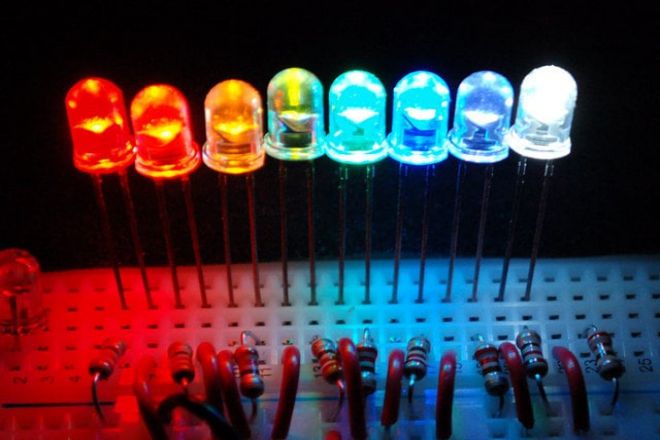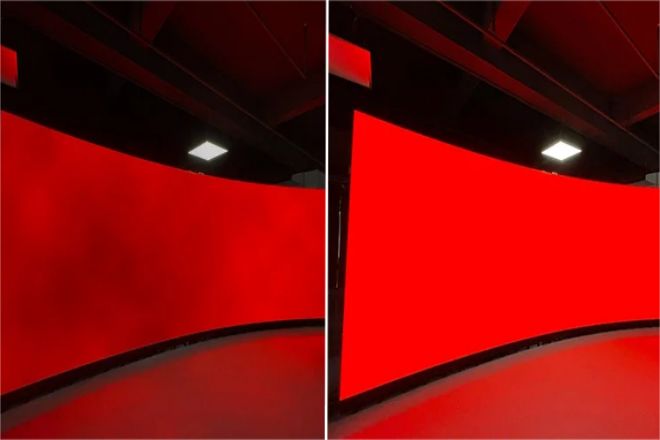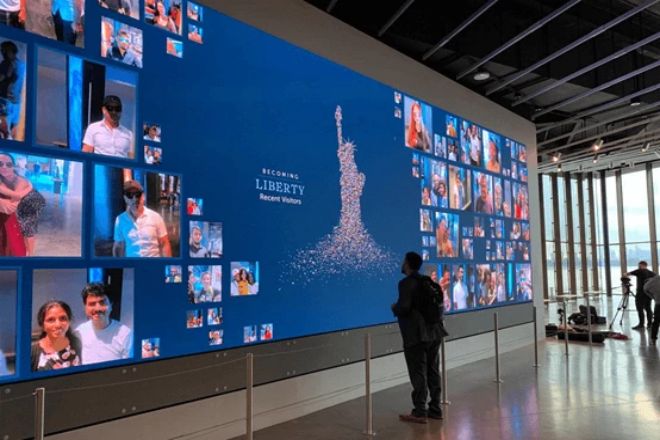Introduction

In today’s era of digitalization and informationization, LED display screens have become an indispensable and important tool in the fields of information dissemination, advertising display, culture, and entertainment. Its high brightness, high definition, long life, and other characteristics enable it to perform well in various situations.
However, as the color tone of the LED display screen is a key factor that directly affects the audience’s visual experience, its adjustment and optimization are particularly important.
1. Basic knowledge of LED display color hue

The basic knowledge of LED display color tone covers many aspects. The following are detailed answers to your questions:
1). Color Basics: Hue, Value and Saturation
- Hue:
Hue is the primary characteristic of color and the most accurate standard for distinguishing various colors. In fact, any color other than black, white, and gray has the attribute of hue, and hue is composed of primary colors, secondary colors, and complex colors. The hue circle is the most intuitive manifestation of hue, which can clearly reflect the relationship and changes between colors.
- Value:
Value refers to the brightness of a color. Various colored objects produce light and dark colors due to differences in the amount of light they reflect. There are two situations of color brightness: one is the same hue but different brightness; the other is the different brightness of various colors.
- Saturation:
Saturation refers to the vividness of a color, also known as the purity of the color. Saturation depends on the ratio of chromatic and achromatic components (grey) in the color. The greater the color component, the greater the saturation; the greater the achromatic component, the smaller the saturation.
2). LED display color generation principle
- RGB color mode:
RGB color mode is a color standard in the industry. It obtains various colors by changing the three color channels of red (Red), green (Green), and blue (Blue) and superposing them on each other. Various colors. RGB represents the colors of the three channels: red, green, and blue. This standard includes almost all colors that human vision can perceive and is one of the most widely used color systems.
- Color depth and resolution:
Color depth refers to the number of colors the display can display, usually expressed in bits. The higher the color depth, the richer the displayed colors and the more delicate the picture. Resolution refers to the number of pixels on the display, usually expressed in terms of the number of horizontal pixels and the number of vertical pixels. The higher the resolution, the clearer the display.
3). The importance of color tone adjustment
- Improve the visual experience:
By adjusting the color tone of the LED display, you can make it more in line with the visual habits of the human eye, thereby improving the viewing experience. For example, when displaying pictures of natural scenery, appropriately increasing the saturation of green and blue can make the picture more fresh and natural.
When displaying pictures of products, adjusting the hue and brightness can highlight the characteristics of the product and attract the audience’s attention.
- Ensure the accuracy of information transmission:
When displaying information on an LED display, accurate color tones can ensure the accurate transmission of information. For example, when displaying traffic signs, red stop signs and green passing signs have clear color regulations. If the colors are inaccurate, it may lead to misunderstandings and safety hazards. Therefore, by adjusting the color hue of the LED display, the accuracy and reliability of the information can be ensured.
2. LED display color tone adjustment method
The adjustment methods of LED display color hue usually include software adjustment and hardware adjustment. The following are the specific adjustment methods and steps:
1). Software adjustments
1.1). Using LED display control software
Color calibration:
Many LED display control software provide color calibration functions. With this feature, the color of the display can be precisely adjusted to make it more accurate and realistic.
Preset mode selection:
Many software provide a variety of preset modes, such as standard, vivid, soft, etc. Users can select the appropriate mode according to their actual needs to quickly adjust the color tone of the display.
Custom color settings:
In addition to the preset modes, users can also customize color settings according to their needs. By adjusting the brightness of the three primary colors, red, green, and blue, various color combinations and changes can be achieved.
1.2). Detailed explanation of adjustment steps
Connect the display screen to the control software:
First, you need to connect the LED display screen to the control software. This usually requires the use of a specific cable or wireless connection.
Enter the color adjustment interface:
After the connection is successful, open the control software and enter the color adjustment interface. This interface usually displays the current display color settings and preview effects.
Color adjustment according to needs:
In the color adjustment interface, users can make color adjustments according to actual needs. Use the color calibration feature to make precise adjustments, or choose a suitable preset mode or custom color settings.
Save and apply settings:
After making adjustments, remember to save and apply your settings. In this way, the LED display will display according to the new color setting.
2). Hardware tuning
2.1). Replace LED lamp beads or modules.
Choose the right LED lamp bead or module:
If there are serious problems with the color tone of the LED display, the LED lamp bead or module may need to be replaced. Before replacement, you need to select the appropriate LED lamp beads or modules to ensure that they are compatible with the original display and meet the usage requirements.
Replacement process and precautions:
When replacing LED lamp beads or modules, you need to pay attention to the following points: First, make sure the display is turned off and disconnected from the power supply; second, disassemble and install according to the instructions or the guidance of professionals; finally, Test after replacement is complete to ensure the display is functioning properly.
2.2). Adjust the display brightness and contrast.
Use physical buttons or remote controls on the display:
Most LED displays come with physical buttons or remote controls for adjusting brightness and contrast. Users can enter the settings interface through these buttons or the remote control and then follow the prompts to make adjustments.
The impact of brightness and contrast on color hue:
Brightness and contrast are important factors that affect the color hue of LED displays. Appropriately increasing the brightness can make the picture brighter and more vivid; appropriately increasing the contrast can enhance the layering and three-dimensionality of the picture.
However, it should be noted that excessive brightness or contrast may cause problems such as picture distortion or eye fatigue. Therefore, reasonable settings need to be made based on actual needs and environmental conditions when adjusting.
3. LED display color tone adjustment skills

The adjustment of the color tone of the LED display not only involves technical operations but also requires consideration of some practical application skills. The following are tips for adjusting the color tone of LED displays:
- Color balance adjustment
The balance of red, green, and blue (RGB) colors is key. Ensure that the brightness, contrast, saturation, and other parameters of these three colors reach a relatively balanced state to avoid color casts.
When making color balance adjustments, you can use professional color testing tools or software to obtain more accurate adjustment results.
- Scene adaptation
Choose appropriate color shades according to different application scenarios. For example, in an indoor environment, you can choose softer and more comfortable colors; in an outdoor environment, you need to consider factors such as light and weather and choose brighter and more vivid colors.
For application scenarios such as commercial advertising, appropriate color tones can be selected to enhance the audience’s perception and memory based on factors such as brand image and promotional content.
- Color Psychology Applications
Utilize the principles of color psychology to enhance the audience’s viewing experience by selecting appropriate color tones. For example, red can inspire enthusiasm and energy in your audience, while blue can bring a sense of calm and trust.
When adjusting color tones, you can consider the relationship between color, emotion, and brand image to achieve better publicity effects.
- Regular inspection and maintenance
Regularly check the color performance of the LED display to ensure it is always in optimal condition. This includes checking that colors are accurate, brightness is even, etc.
Clean dust and dirt from the display surface to keep it clean. At the same time, check whether the connecting wire is loose or damaged, and replace or repair it in time.
By following the above tips, you can better adjust the color tone of the LED display, improve the audience’s viewing experience, and enhance the publicity effect. At the same time, this also requires professional technical personnel and tool support to ensure the accuracy and effectiveness of the adjustment process.
Conclusion
After a detailed discussion of the methods and techniques for adjusting the color and hue of LED displays, we can easily find that the adjustment of color and hue is not only a technical job but also an art.
It requires us to have an in-depth understanding of color science, master adjustment techniques, and make flexible adjustments based on actual application scenarios. Only in this way can we ensure that the LED display screen can present the best color performance in various environments and bring a more shocking and comfortable visual experience to the audience.
Finally, if you want to know more about LED displays, please get in touch with us.
